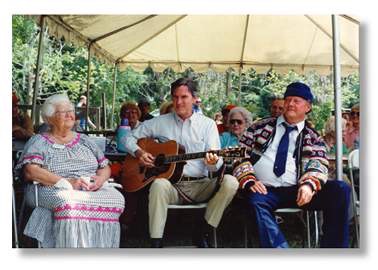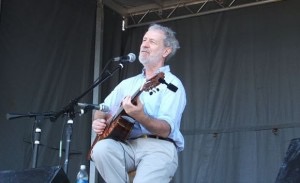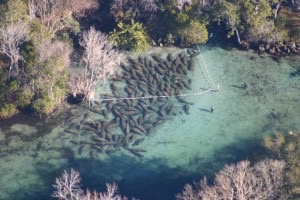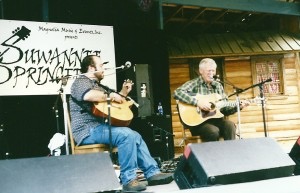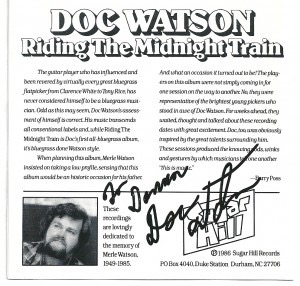Click here to hear full length archival interviews with Will McLean (recorded by Donna Green-Townsend in 1985 & 1987)

Will McLean is considered the “Father of Florida Folk.” The “Black Hat Troubadour” travelled all across his beloved state writing hundreds of poems, songs and stories. After his death in 1990 he was inducted into the Florida Artists Hall of Fame. Each year Florida singer songwriters gather at the Will McLean Folk Festival to honor him. McLean wanted to save Florida through his music. Each year the Will McLean Foundation holds a “Best New Florida Song Contest“ to keep McLean’s mission alive.
 To watch archival video of Will McLean CLICK HERE:
To watch archival video of Will McLean CLICK HERE:
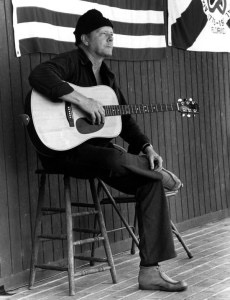
Donna Green-Townsend interviewed McLean 5 years before his death in 1985 and again in 1987. She also talked with some of the musicians who were inspired to write about Florida because of Will McLean. (Scroll down to see the full feature transcript. You can also hear Will’s most popular songs below)
In 1988 Will McLean joined storyteller Cousin Thelma Boltin and his music buddy Gamble Rogers in Cross Creek, FL for the 50th Anniversary of “The Yearling” celebration at the farm of the late Pulitzer Prize-winning author, Marjorie Kinnan Rawlings. See a few snippets from a rare video recorded at that event below:
 Here is the audio of the eulogy given by the late Gamble Rogers (inducted into the Florida Artists Hall of Fame in 1996) at the memorial service for Will McLean in January of 1990 at the Thomas Center in Gainesville, FL.
Here is the audio of the eulogy given by the late Gamble Rogers (inducted into the Florida Artists Hall of Fame in 1996) at the memorial service for Will McLean in January of 1990 at the Thomas Center in Gainesville, FL.

On January 24th, 1990, following the memorial service at Gainesville’s Historic Thomas Center in Gainesville, FL, friends gathered at Gore’s Landing to disperse Will McLean’s ashes into the Ocklawaha River. Before he died, McLean told Margaret Longhill that he had hoped to light a small campfire one last time at Gore’s Landing by the Ocklawaha River in Marion County, his favorite campsite. Some of those in attendance were Margaret Longhill, Don Grooms, Dale Crider and family, Donna Green-Townsend and family, Wayne Martin and Bobby Hicks to name a few. In this brief recording, you will hear a small portion of that special ceremony at the river.

A few months after the memorial service for McLean, friends gathered once again at Gore’s Landing for a special dedication. A special sign was placed at the site marking the place considered as Will’s favorite camping spot. Speakers included Margaret Longhill, Gamble Rogers, Frank Thomas and Bobby Hicks among others. See additional pictures from the ceremony below.
 In 1996 Will McLean was officially inducted into the Florida Artists Hall of Fame. He was the first folk musician given this honor in Florida. Margaret Longhill accepted this award from then Secretary of State Sandra Mortham in Tallahassee. Performing some of McLean’s songs that day were Frank Thomas (who is also now in the Florida Artists Hall of Fame), Mary Ann Dinella and Wayne Martin. See additional pictures from the ceremony below.
In 1996 Will McLean was officially inducted into the Florida Artists Hall of Fame. He was the first folk musician given this honor in Florida. Margaret Longhill accepted this award from then Secretary of State Sandra Mortham in Tallahassee. Performing some of McLean’s songs that day were Frank Thomas (who is also now in the Florida Artists Hall of Fame), Mary Ann Dinella and Wayne Martin. See additional pictures from the ceremony below.
Transcription of the feature above:

Will McLean, “It’s very important that Florida keep her past and I’m but one of the few writers and I have not even scratched the surface of the richness and the deepness of the lore and legends of Florida.” (Florida Sand)

Musician Pete Seeger once wrote, “Will McLean’s songs will be sung as long as there is a Florida.” McLean lived a simple life, always steering away from fame and fortune just when it seemed he had achieved it. Most of the time he travelled the state in dilapidated vehicles, only taking with him a bag of taters and onions, a fishing hook and a bottle of cheap wine, pawning many of his guitars. In a never-before aired interview, McLean shared his story in 1985, just five years before his death.
Will McLean, “I’m a millionaire a million times over. I’m not talking about money rich. I’m rich in the beauty of Florida and nature.”
That earthy spirit lives on today in many of the Florida songwriters attending the annual Will McLean Music Festival named in his honor. Singer Songwriter from Windsor, Dale Crider, “I think he made a lot of people in Florida aware that they could write and sing and dance and perform Florida.”

Florida’s Black Hat Troubadour was known for his genteel manner, but his voice thundered on the marble stage of the Florida Folklife Festival in White Springs as he captured stories in song about green turtles laying eggs on the shores of St. Augustine (Conch Island)
and Sandhill Cranes in Payne’s Prairie, and some not so pretty stories about a wild hog in Gulf Hammock (Wild Hog)
and a panther chase resulting in a deadly encounter with a snake in Tate’s Hell. (Tate’s Hell)

Singer-Songwriter Don Grooms was one of Will McLean’s closest musical buddies, “Will liked songs about individual human beings and if you pay attention to his repertoire of songs there was Cush Holston, Scotty the drummer, the guy in Tate’s Hell, Osceola.” (Osceola)
Will McLean inspired many songwriters to explore the heritage of the state and themselves. Grooms, a Native American, remembers how McLean encouraged him to write the story of the bloody skirmish between the Spanish explorers and Native Americans in Payne’s Prairie.
Don Grooms, “I came up with a five minute song called “Vitachuco” and I played it for Will and he said play that for me again and after I finished he said, ‘Grooms you have finally justified your existence.” (Vitachuco)

One of the first singer/songwriters to carry on Will McLean’s love for Florida through song is musician and wildlife biologist Dale Crider. Crider has entertained national and international audiences with his wildlife and wilderness songs, and he credits his beginning to Will McLean: (Hold Back The Waters)
Dale Crider, “Hold Back the Waters was the song that started my whole career in writing about the environment. Will was singing that on stage at the Florida Folklife Festival and I said, ya, ya, if it can be that good you know to sing about a place or a region or an object in Florida, I can do that.”
Both Dale Crider and Don Grooms helped to disperse Will McLean’s ashes into the Ocklawaha River on January 18th, 1990. Dale emotionally recalls how his friend’s last wishes coincided so well with his on-going desire to return to the land where the wind is born.
Dale Crider, “And I envisioned that that night there were herons and egrets that caught minnows that had Will’s ashes in them and flew him up to the tree tops and roosted him that night and actually his soul could have been transferred to something like a hawk.” (My Soul Is A Hawk)

The Will McLean Music Festival honoring the Father of Florida Folk is held each March at the Sertoma Youth Ranch located seven miles west of Dade City in Central Florida. For more information go to the website www.willmclean.com.
Will loved to watch the Florida Sandhill Cranes “dance and prance” on Payne’s Prairie near Gainesville, FL. One of his more beloved songs described the experience. Here’s a video recorded of sandhill cranes produced by Donna Green-Townsend with Will singing his “Courtship Dance of the Florida Sandhill Crane” to music played by musician and luthier David Beede and Kate Kennedy (music recorded at one of Will’s last live recorded concerts at the historic Thomas Center in Gainesville in Nov. of 1985).
Will McLean and Cousin Thelma Boltin Share Christmas Memories (aired on WUFT in December of 1987)

Transcription of the Feature: (Oh Christmas Tree) Computerized teddy bears and video cassette recorders are a long way from the gifts of fruit and simple toys of Christmases past. Folklorist Cousin Thelma Boltin and singer song writer Will McLean share some of their most memorable Christmases.
Cousin Thelma Boltin: “In early times everybody went out and cut their own Christmas trees. It was unthinkable to buy a tree and there was no such thing as an artificial tree. That would have been disgraceful to have an artificial tree. And it was always a great day when we decided we’d go get the tree and we didn’t get it too long before Christmas. But in the early days we’d go out with the horse and wagon and then in modern times we’d go out in the model T or in the Coca Cola Truck because my daddy was the Coca Cola man. And we loved to get a Cedar, that was our favorite kind. But if we couldn’t find a Cedar, as they got scarce, um, we’d get a shortleaf pine. It smells so wonderful in the house. It’s a little more difficult to decorate than the Cedar and a Cypress was pretty but boy it was sticky and hard to handle and do anything with. And once or twice I can remember, and this was before our Cedar was protected, and thank goodness it is protected, it’s against the law to cut Cedar down anywhere, I mean cut Holly, and we would get a Holly tree. And of course that was sticky, but it was beautiful because especially if it were full of berries.” (OH CHRISTMAS TREE).

Cousin Thelma Boltin: “We never did decorate our tree until Christmas Eve and we used the parlor on state occasions and this was a state occasion so the fire would be built in the fireplace and the candles put on the mantlepiece and then we’d decorate our tree. In early days, I don’t believe, we never did put candles on our tree. Momma considered that too dangerous and we hailed with delight the day when we could get strings of electric lights to put on the tree. And of course, it was easy to get pretty ornaments from Woolworths and from what was the other ten cent store, we had two in town, McCrowry’s and get beautiful ornaments. We never did string popcorn to go on our tree but we put ropes of tinsel on it. And oh we just thought our tree was the prettiest one in the neighborhood of course. A child asked me today if we ever slept in the living room you know with the tree and we said ‘oh no, Santy Claus couldn’t come if we stayed with the Christmas tree. But of course we were up long before day to see what Santy had left us.” (Jolly ‘Ole St. Nick)

Will McLean: “Well, my first recollection is of a contraption bought that you could ride on. I got a little ‘ole bitty, tiny kind of like a kitty car thing. It was all painted up good uh, kind of a tricycle and I don’t know why I thought about that. It was the first thing that came to my mind. And of course over the fireplace we’d hang uh an old knit, Thelma you remember those old socks that uh they used to cost about a nickel a pair, old red and blue socks. Kind of cotton socks. We’d nail them up over the mantel and this was Christmas Eve.” (Silent Night)

Will McLean: “Lady Boltin asked me once about if I could recall shootin’ firecrackers on Christmas. And uh, I couldn’t remember ever at that early stage, early Christmases, shootin’ any kind of a firecracker or explosives. But to get back to the stockin’ and Christmas mornin’, uh most the times I would have a little ‘ole 25 cent American Ace harmonica in the stockin’ wrapped in tissue paper and I’d have a piece of ‘ole peppermint stick candy and usually an apple, and an orange and a banana and I hope this won’t create any problems, three little nuts that uh, they were Brazil nuts. You remember what we used to call them?(laugh) But anyway, that was Christmas and of course on Christmas Day the big ‘ole table in the dining room. There’d be about 25 or 30 people there. And kids runnin’ around everywhere. All the families and mothers and their children there. Uh, lord you could just smell the wonderful, wonderful and that, those were my Christmases up until I was about nine years of age. And it’s good to go back there and think about it in time and place, be with my granddaddy and the people that I loved and who loved me.” (Chesnuts Roasting On An Open Fire)

Cousin Thelma Boltin: “One of the things that we always got, we wore them out one year to the next were skates. We loved Skates and always asked Santy to bring us skates (laugh). And always on Christmas Eve for supper we had oyster stew. That was the Christmas Eve supper ‘cuz it was easy to fix and everybody liked it. We could do it in a hurry and get in the living room to fix the tree (chuckle). And that went on for many, many years. And then I went off to college and I shocked the neighbors by not going to FSU or Florida State College for women in those days. They weren’t allowed. Ladies didn’t go to the University until the late 40s you know. So I went to Emmerson College in Boston and that was truly Yankee land in everyway and so I had my first White Christmas up there. (White Christmas) I was such a long way away that I stayed up there for the Christmas holidays and I had made friends with a fellow freshman. Her name was Juliet Phillips and she took pity on me and invited me out to her home in Jamaica Plain and oh it was a thrill. Everybody in Jamaica Plain it seemed to me put lighted candles in their windows from the attic to the basement and to get out on the street and see all those candles just after dark was a thrilling thing. And we decided that we would go into Boston. This was on Christmas Eve and up on Beacon Hill there was a tradition of having carol singers and bellringers and no cars were allowed up there. Everybody walked. And uh, many homes up there had open house and they’d be serving oh hot cider and goodies, doughnuts and the carol singers would be first on this corner and then on that corner. And then we’d come upon the bellringers. Then right at midnight over on the piazza a beautiful old Trinity church uh trumpeters stepped out and played ‘Oh Come All Ye Faithful’.” (Oh Come All Ye Faithful)
Many of Will McLean’s stories, poems, music recordings, correspondence and photos are now being housed in the Special Collections area of the George A. Smathers Libraries at the University of Florida.
Gallery of Photos below are courtesy of the Will McLean Foundation












